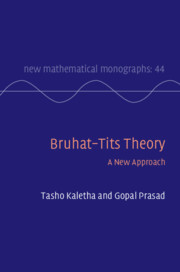Book contents
- Frontmatter
- Dedication
- Contents
- Illustrations
- Tables
- Introduction
- Part One Background and Review
- Part Two Bruhat–Tits Theory
- Part Three Additional Developments
- 10 Residue Field of Dimension 1
- 11 Component Groups of Integral Models
- 12 Finite Group Actions and Tamely Ramified Descent
- 13 Moy–Prasad Filtrations
- 14 Functorial Properties
- 15 The Buildings of Classical Groups via Lattice Chains
- Part Four Applications
- Part Five Appendices
- References
- Index of Symbols
- General Index
10 - Residue Field of Dimension 1
from Part Three - Additional Developments
Published online by Cambridge University Press: 16 May 2023
- Frontmatter
- Dedication
- Contents
- Illustrations
- Tables
- Introduction
- Part One Background and Review
- Part Two Bruhat–Tits Theory
- Part Three Additional Developments
- 10 Residue Field of Dimension 1
- 11 Component Groups of Integral Models
- 12 Finite Group Actions and Tamely Ramified Descent
- 13 Moy–Prasad Filtrations
- 14 Functorial Properties
- 15 The Buildings of Classical Groups via Lattice Chains
- Part Four Applications
- Part Five Appendices
- References
- Index of Symbols
- General Index
Summary
Establishes additional properties that are valid under the assumption that the residue field has dimension at most 1. These include the vanishing of the first Galois cohomology for simply connected semi-simple groups and the classification of connected reductive groups in terms of affine Dynkin diagrams.
- Type
- Chapter
- Information
- Bruhat–Tits TheoryA New Approach, pp. 389 - 419Publisher: Cambridge University PressPrint publication year: 2023

